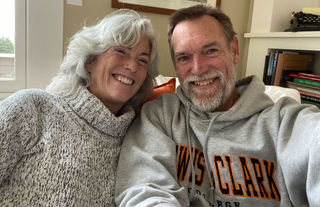Relationships
Erica Bauermeister: How to Make a House a Home
Nesting and "home" take on new meaning in days of self-isolation.
Posted March 23, 2020

It is an odd thing, falling in love with a house. We encounter an inanimate object, made of wood and nails and glass and pipes—no moving blood or muscles, no sparkling brain. And yet, we are drawn to it, just like a human soulmate we spot across a crowded room. We enter a front door, and, suddenly, we know this house is ours.
As someone who has been a renovator and a real estate agent as well as a writer, I can tell you that the reasons for these decisions are rarely logical. Before setting out on our search for a home, we make lists of our needs—number of bedrooms, baths. We attempt practicality. This is a financial decision, after all; probably the biggest one most of us will ever make. We will be grown-up about it, we swear, although our childhood pinky-swears were probably more enduring. Because then there is "The House," and suddenly, we don’t need a quick commute to work or a big kitchen. The list evaporates into love.
My husband and I are prime examples of this behavior. I was drawn to our first house based on the poetry of its address. I just knew it would be right, and it was. But our biggest leap into irrationality came when, years later, we spotted a wreck of a house in Port Townsend, high on a hill, overwhelmed by trash and vegetation. We weren’t even looking for a house—but there it was, as mangy and unloved as a dog on the side of a highway, running for its life.
The house was stationary, but only in a physical sense. Emotionally, it reached for us, grabbed our imaginations, and pulled us in. I loved the tall, straight walls of its American Foursquare design, the wide front porch, the flowing floor plan I believed would be inside. The house felt generous, in direct contradiction to the trash so jealously hoarded inside it. I wanted to get that trash out, let air and movement into those rooms. Feed the house with love.
It was a big project—too big in many ways. The house was almost a century old. Its foundation was rotten, and the roof was worse. The basement looked like a hazardous materials drop-off center. The trash was the stuff of nightmares, not treasure. It would have been smarter to raze the thing to the ground. And yet, I wanted to take care of this house, and I knew, in some deep and visceral way, that it would take care of me. It was a supremely impractical decision—but then again, many of the best ones are.
And I would hazard that these unexpected choices are not, in fact, as irrational as they appear. The problem is, we are simply looking at the wrong list. We quiz ourselves about the need for an office, a nursery, a dining room. These are crucial issues, but there is another list we don’t even talk about.
As a professional real estate agent, it always felt too invasive for me to ask my clients the question, but in the end, it was the important one: How do you want to feel? Do you crave safety? Comfort? A feeling of adventure? Because it is these emotions that a house appeals to.
We walk into a kitchen that is painted the same butter yellow as our grandmother’s. We enter a loft, its open space rising up above our heads, and suddenly, we feel like artists. It doesn’t matter that we could paint any kitchen that color, or that we have corporate jobs and no time for art. What matters is the feeling of having our emotional desires met. And at that moment, we feel at home.
Are irrational decisions always good? No. Just as the supremely pragmatic ones can leave us feeling an emotional void, the irrational ones are no guarantee of success. Our lives are made better by functioning kitchens, space for children, a yard for a dog. The trick is to acknowledge both lists and to consider how combining them can enrich your life.
The architect Christopher Alexander was a proponent of examining the relationship between people and their habitations. He observed patterns of human behavior and came up with a list of 257 different architectural principles. Among them: A porch allows people a crucial moment to pause and shed their public selves before entering a private world.
Humans gravitate toward rooms with windows on two sides, but they will avoid the part of a house that is down a dark hallway or a deck that is less than six feet wide. A room that is tall and big can leave people circling, uncertain where to land, while window seats and nooks give people a sense of both prospect and refuge, a combination that is invigorating and soothing at the same time. Through Alexander’s principles, psychological needs meet physical space to create designs that are dynamic and energizing.
When we bought our house in Port Townsend, I was being influenced primarily by my emotional list, but I discovered Alexander’s work while we were in the process of renovating. His theories brought our two lists together so that we could see what the house offered, both emotionally and physically, and then consider the changes that could enrich our family’s life going forward.
Because there’s another thing we need to keep in mind: A house not only fits who you are now; it helps determine who you will become. As Winston Churchill once said: “We shape our buildings; and afterward, our buildings shape us.” The houses we live within, the shape and flow of their rooms, encourage us to be particular kinds of people—more, or less, creative, loving, engaged with the outdoors. And thus, when we are choosing or remodeling our houses, it’s always worth taking a step back and adding a third list: Who do I want to be? And how can this house support those goals?
For our house in Port Townsend, that meant keeping the flowing floor plan that is an inherent part of an American Foursquare—so different from its Victorian contemporaries with their small, separated rooms that reinforced social barriers. In contrast, our house feels welcoming, egalitarian. I am an introvert who wants to become more comfortable in social situations. The layout of our house invites company and easy conversation, and when I am within its rooms, I am encouraged to engage and reach out.
A similar goal caused us to deviate from the existing design in one important way. When we bought the house, the kitchen was in a former butler’s pantry, sticking out from the side of the house, and so sodden with leaked rain and grease that the only solution was amputation. But that left no place to cook, and we couldn’t afford to put on a new room.
There was another space, the original kitchen from when the house was built in 1909. It was the fourth square of the main floor but firmly separated from the rest of the rooms, appropriate for a time when cooking was smoky and done by servants. But I had spent too much time in secluded kitchens, and I wanted an architectural prompt to change our family dynamic. So, we opened the wall between the kitchen and the dining room, made a space big enough for four people to be working in there at one time. And low and behold, our patterns started changing.
There are so many ways architecture can jump-start our better selves. If mornings are difficult, look for an east-facing bedroom, where the sun will help you rise. Easy, visible access to a yard will encourage you, or your children, to put down those screens and go outside. Want more intimacy in your relationship? Avoid master bedrooms designed to include a television or desk. And if you want to build a stronger family, choose a house where the living room makes you happy. Chances are, you’ll gather there. Because whether or not we notice, we do what our walls tell us.
Those walls need not be grand, and a solution can be as simple as putting a light at the end of a dark hallway or painting your kitchen that comforting butter-yellow. But the trick, when choosing or remodeling a home, is to pay attention to all three lists: past, present, and future. Wants, needs, and dreams. Using that approach can help us to understand what is inspiring that first rush of love, to see the best parts of what exists and envision changes. The result can be a home that will make you feel more alive.
This post was written by guest blogger Erica Bauermeister, the bestselling author of four novels, including The Scent Keeper and The School of Essential Ingredients. Her books have been translated into over 26 languages and have been chosen for Reese’s Book Club and the Indie Next list. Bauermeister has a Ph.D. in literature and is also the co-author of two readers’ guides: 500 Great Books by Women and Let’s Hear It for the Girls. Her latest book, a memoir-in-essays, is House Lessons: Renovating a Life.




